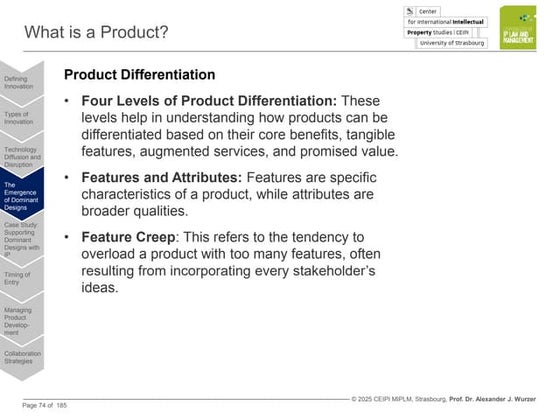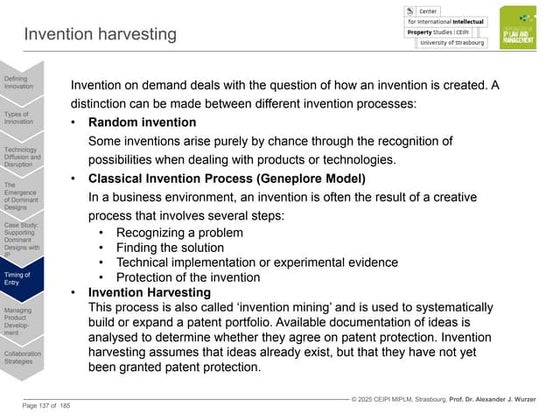Data Models - Department of Computer Science & Engineering
Download as PPT, PDF0 likes60 views
Why data models are important? About the basic data-modeling building blocks. How the major data models evolved? How data models can be classified by level of abstraction?
1 of 30
Download to read offline


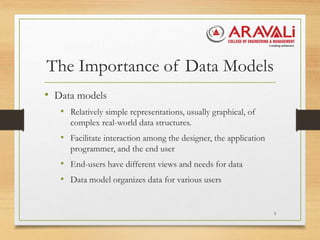

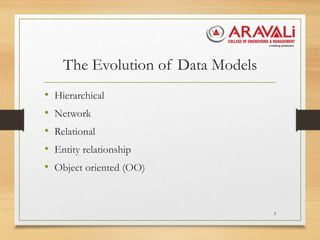


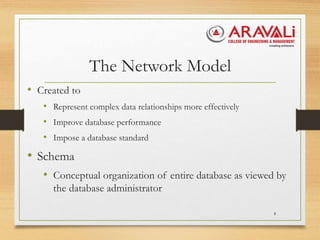



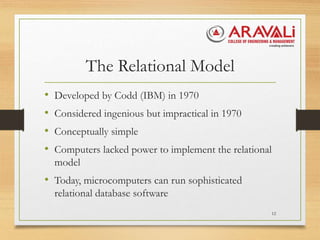
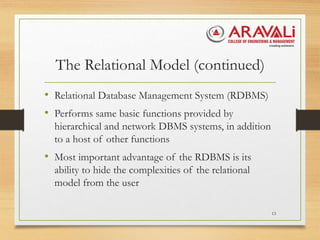

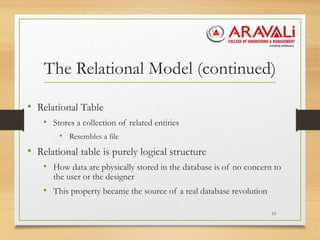
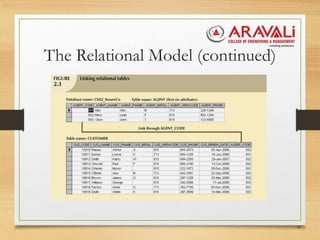
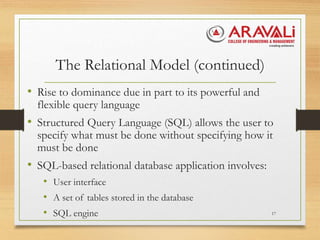

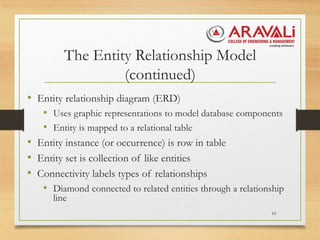

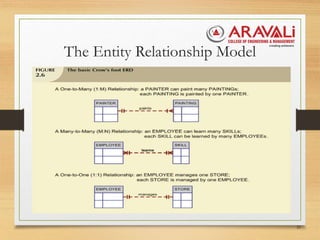
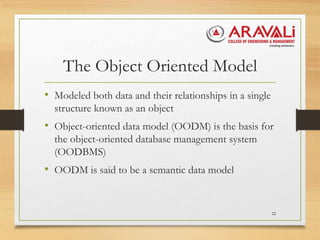
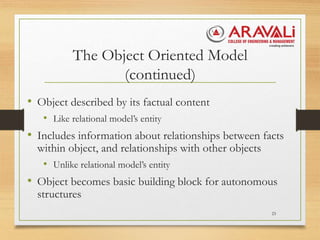

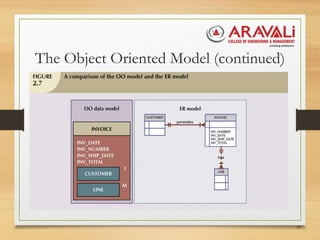

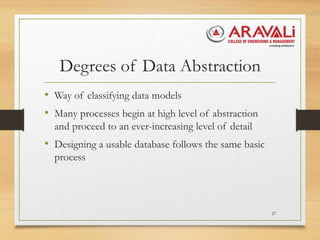
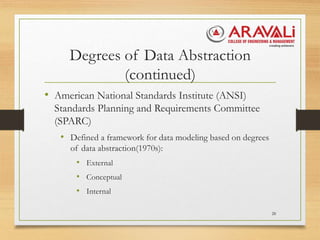

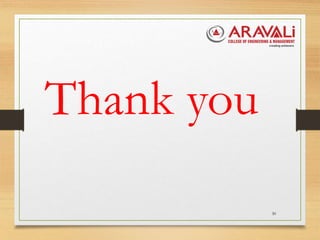
Recommended
Chapter-3-Lesson 1 DM/ Data-Models.ppt/pptx



Chapter-3-Lesson 1 DM/ Data-Models.ppt/pptxmicayaseloisa
╠²
Data models provide simplified representations of complex real-world data structures and facilitate communication between database designers and users. They organize data into entities, attributes, and relationships and incorporate business rules. Common data models include the hierarchical, network, relational, and entity-relationship models. Data models can be classified by their level of abstraction, from external views tailored for end users to internal schemas depicting the database structure.Fundamentals of Database ppt ch02



Fundamentals of Database ppt ch02Jotham Gadot
╠²
This document discusses data modeling and different data models. It covers the evolution of data models from hierarchical to network to relational models. It also discusses object-oriented and XML data models. Key aspects of data modeling include entities, attributes, relationships, and constraints. Different abstraction levels for data modeling include external, conceptual, and internal views.02010 ppt ch02



02010 ppt ch02Hpong Js
╠²
The document provides an overview of data models and modeling. It discusses the importance of data modeling in reconciling different views of data and reducing complexity. The basic components of data models are entities, attributes, relationships, and constraints. Business rules influence database design by describing characteristics of data within an organization. Major models discussed include the hierarchical, network, relational, entity-relationship, object-oriented, and extended relational models. Later models built upon the strengths and addressed weaknesses of earlier approaches. Data modeling involves different levels of abstraction from an external view to more detailed internal and conceptual perspectives.Data models



Data modelsDhani Ahmad
╠²
The document discusses data modeling and different data models. It describes the evolution of data models from hierarchical to network to relational models. It also covers the entity relationship and object-oriented models. The key points are that data modeling helps reconcile different views of data, business rules inform database design, and the conceptual model provides an integrated global view of the database.data modeling and models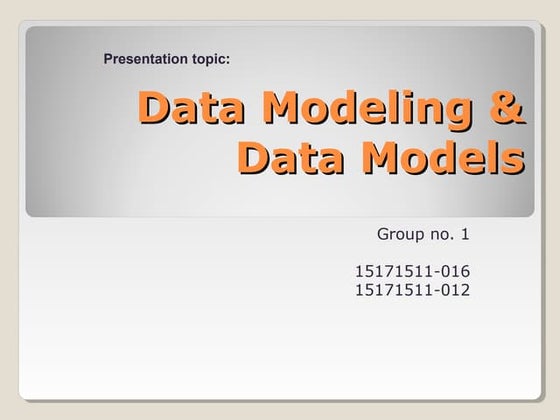



data modeling and modelssabah N
╠²
This document provides an overview of data modeling, including definitions of key concepts like data models and data modeling. It describes the evolution of popular data models from hierarchical to network to relational to entity-relationship to object-oriented models. For each model, it outlines the basic concepts, advantages, and disadvantages. The document emphasizes that newer data models aimed to address shortcomings of previous approaches and capture real-world data and relationships.In this chapter, you will learn: About data modeling and why data models are ...



In this chapter, you will learn: About data modeling and why data models are ...awadmohamedelnur
╠²
Database SystemDatabase Models, Client-Server Architecture, Distributed Database and Classif...



Database Models, Client-Server Architecture, Distributed Database and Classif...Rubal Sagwal
╠²
Introduction to Data Models
-Hierarchical Model
-Network Model
-Relational Model
-Client/Server Architecture
Introduction to Distributed Database
Classification of DBMS
Data Models.ppt



Data Models.pptAnshikaGoel42
╠²
The document discusses different types of data models and their evolution. It describes hierarchical, network, relational, entity relationship, and object oriented models. Each new model aimed to improve on limitations of previous approaches. The models can be classified at different levels of abstraction, from external views specific to business units to conceptual and internal representations within the database.oracle 



oracle Vilasita Nandamuri
╠²
The document discusses database fundamentals and provides an overview of key concepts including:
- The objectives of learning about database systems and their basic components
- An introduction to Entity Relationship (ER) modeling for conceptual database design
- The different types of database systems including relational, hierarchical, network, and object-oriented
- How to create a database environment using ER modeling to design the structure and relationships of dataTypes of Database Models



Types of Database ModelsMurassa Gillani
╠²
The document discusses different database models including hierarchical, network, relational, entity-relationship, object-oriented, object-relational, and semi-structured models. It provides details on the characteristics, structures, advantages and disadvantages of each model. It also includes examples and diagrams to illustrate concepts like hierarchical structure, network structure, relational schema, entity relationship diagrams, object oriented diagrams, and XML schema. The document appears to be teaching materials for a database management course that provides an overview of various database models.Different data models



Different data modelsmadhusha udayangani
╠²
This document discusses different types of data models, including hierarchical, network, relational, and object-oriented models. It focuses on explaining the relational model. The relational model organizes data into tables with rows and columns and handles relationships using keys. It allows for simple and symmetric data retrieval and integrity through mechanisms like normalization. The relational model is well-suited for the database assignment scenario because it supports linking data across multiple tables using primary and foreign keys, and provides query capabilities through SQL.Chapter ŌĆō 2 Data Models.pdf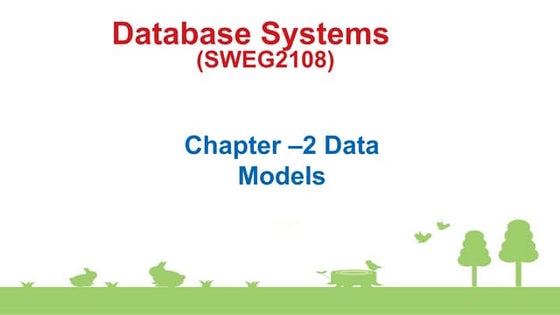



Chapter ŌĆō 2 Data Models.pdfTamiratDejene1
╠²
The document discusses key concepts in relational data models including entities, attributes, relationships, and constraints. It provides examples of each concept and explains how they are the basic building blocks used to structure data in a relational database. Specific types of entities, attributes, relationships and their properties are defined, such as one-to-one, one-to-many, and many-to-many relationships. Overall, the document serves as an introduction to fundamental concepts in relational data modeling.introduction-to-dbms-unit-1.ppt



introduction-to-dbms-unit-1.pptrekhasai2468
╠²
This document provides an overview of a database management systems course. The course objectives are to understand the purpose and concepts of DBMS, apply database design and languages to manage data, learn about normalization, SQL implementation, transaction control, recovery strategies, storage, and indexing. The outcomes are knowledge of various data models, database design process, transaction management, users and administration. Key topics covered include the relational and entity-relationship data models, database design, transactions, and database users and administration.Mis assignment (database)



Mis assignment (database)Muhammad Sultan Bhatti
╠²
1. The document discusses different types of database management systems and data models including DBMS, RDBMS, file systems, and manual systems.
2. It provides brief definitions and examples of each type as well as their advantages and disadvantages.
3. The key database models covered are hierarchical, network, relational, and object-oriented models, with descriptions of their characteristics and how they have evolved over time.Database management system introduction.pptx



Database management system introduction.pptxÓ░¦Ó░ŠÓ░ĄÓ░©Ó▒Ź Ó░ĢÓ▒üÓ░«Ó░ŠÓ░░Ó▒Ź
╠²
Database Management System Chapter-2 Database System Concepts and Architecture



Chapter-2 Database System Concepts and ArchitectureKunal Anand
╠²
This document provides an overview of database management systems concepts and architecture. It discusses different data models including hierarchical, network, relational, entity-relationship, object-oriented, and object-relational models. It also describes the 3-schema architecture with external, conceptual, and internal schemas and explains components of a DBMS including users, storage and query managers. Finally, it covers database languages like DDL, DML, and interfaces like menu-based, form-based and graphical user interfaces.DBMS data modeling.pptx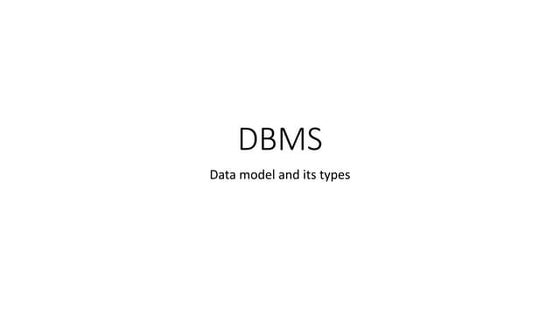



DBMS data modeling.pptxMrwafaAbbas
╠²
The document discusses three types of data models: conceptual, logical, and physical. A conceptual data model defines business concepts and rules and is created by business stakeholders. A logical data model defines how the system should be implemented regardless of the specific database and is created by data architects and analysts. A physical data model describes how the system will be implemented using a specific database management system and is created by database administrators and developers.Design approach



Design approachRaaz Karkee
╠²
This document discusses data modeling and design approaches. It defines key terms like database, data model, and schema. It describes common data models like hierarchical, relational, network, object-oriented, and entity-relationship models. It also compares data models and schemas, noting that data models define data structure while schemas represent data models using database syntax. Finally, it outlines top-down and bottom-up design approaches, where top-down starts generally and moves to specifics while bottom-up begins with specifics and moves generally.lecture5 (1) (2).pptx



lecture5 (1) (2).pptxRabiullahNazari
╠²
The lecture covers several key topics in database systems including:
1. An overview of database concepts such as data models, normalization, data integrity restrictions, query optimization and processing, and SQL.
2. Parallel processing of data and recovery methods.
3. Database design and development including object-relational mapping technologies.
4. Distributed, parallel and heterogeneous databases including definitions and examples of each.DatabaseManagementSystem.pptx



DatabaseManagementSystem.pptxuwmctesting
╠²
The document discusses several books on database management systems and their authors. It also provides an overview of key concepts in DBMS including what a database and DBMS are, the purpose of database systems, levels of abstraction, instances and schemas, data independence, different data models, database languages, the roles of database administrators and users.4- DB Ch6 18-3-2020.pptx



4- DB Ch6 18-3-2020.pptxShoaibmirza18
╠²
The document discusses databases and data warehouses. It explains the differences between traditional file organization and database management. Relational and object-oriented database models are used to construct and manipulate databases. Data modeling creates a conceptual design for databases. Data is extracted from transactional databases and transformed for loading into data warehouses to support analysis and decision making.DBMS topic in PU



DBMS topic in PUEerla Rajasekhar
╠²
This document provides an overview of different database models and concepts. It discusses flat file/sequential, hierarchical, network, relational, entity-relationship, and object-oriented database models. For each model, it describes the basic concepts, examples, advantages and disadvantages. Key concepts covered include entities, attributes, relationships, normalization, data redundancy, and database management systems.B.Tech ME.pptx



B.Tech ME.pptxacemindia
╠²
Aravali College of Engineering is a prestigious educational institution known for its commitment to providing quality technical education and fostering all-round development of its students. Established with a vision to excel in engineering education and research, the college has earned a reputation for producing skilled professionals who contribute to the technological advancement of society.SOFTWARE TESTING



SOFTWARE TESTINGacemindia
╠²
Testing is the process of evaluating a system or its component(s) with the intent to find whether it satisfies the specified requirements or not. In simple words, testing is executing a system in order to identify any gaps, errors, or missing requirements in contrary to the actual requirements.More Related Content
Similar to Data Models - Department of Computer Science & Engineering (20)
Data Models.ppt



Data Models.pptAnshikaGoel42
╠²
The document discusses different types of data models and their evolution. It describes hierarchical, network, relational, entity relationship, and object oriented models. Each new model aimed to improve on limitations of previous approaches. The models can be classified at different levels of abstraction, from external views specific to business units to conceptual and internal representations within the database.oracle 



oracle Vilasita Nandamuri
╠²
The document discusses database fundamentals and provides an overview of key concepts including:
- The objectives of learning about database systems and their basic components
- An introduction to Entity Relationship (ER) modeling for conceptual database design
- The different types of database systems including relational, hierarchical, network, and object-oriented
- How to create a database environment using ER modeling to design the structure and relationships of dataTypes of Database Models



Types of Database ModelsMurassa Gillani
╠²
The document discusses different database models including hierarchical, network, relational, entity-relationship, object-oriented, object-relational, and semi-structured models. It provides details on the characteristics, structures, advantages and disadvantages of each model. It also includes examples and diagrams to illustrate concepts like hierarchical structure, network structure, relational schema, entity relationship diagrams, object oriented diagrams, and XML schema. The document appears to be teaching materials for a database management course that provides an overview of various database models.Different data models



Different data modelsmadhusha udayangani
╠²
This document discusses different types of data models, including hierarchical, network, relational, and object-oriented models. It focuses on explaining the relational model. The relational model organizes data into tables with rows and columns and handles relationships using keys. It allows for simple and symmetric data retrieval and integrity through mechanisms like normalization. The relational model is well-suited for the database assignment scenario because it supports linking data across multiple tables using primary and foreign keys, and provides query capabilities through SQL.Chapter ŌĆō 2 Data Models.pdf



Chapter ŌĆō 2 Data Models.pdfTamiratDejene1
╠²
The document discusses key concepts in relational data models including entities, attributes, relationships, and constraints. It provides examples of each concept and explains how they are the basic building blocks used to structure data in a relational database. Specific types of entities, attributes, relationships and their properties are defined, such as one-to-one, one-to-many, and many-to-many relationships. Overall, the document serves as an introduction to fundamental concepts in relational data modeling.introduction-to-dbms-unit-1.ppt



introduction-to-dbms-unit-1.pptrekhasai2468
╠²
This document provides an overview of a database management systems course. The course objectives are to understand the purpose and concepts of DBMS, apply database design and languages to manage data, learn about normalization, SQL implementation, transaction control, recovery strategies, storage, and indexing. The outcomes are knowledge of various data models, database design process, transaction management, users and administration. Key topics covered include the relational and entity-relationship data models, database design, transactions, and database users and administration.Mis assignment (database)



Mis assignment (database)Muhammad Sultan Bhatti
╠²
1. The document discusses different types of database management systems and data models including DBMS, RDBMS, file systems, and manual systems.
2. It provides brief definitions and examples of each type as well as their advantages and disadvantages.
3. The key database models covered are hierarchical, network, relational, and object-oriented models, with descriptions of their characteristics and how they have evolved over time.Database management system introduction.pptx



Database management system introduction.pptxÓ░¦Ó░ŠÓ░ĄÓ░©Ó▒Ź Ó░ĢÓ▒üÓ░«Ó░ŠÓ░░Ó▒Ź
╠²
Database Management System Chapter-2 Database System Concepts and Architecture



Chapter-2 Database System Concepts and ArchitectureKunal Anand
╠²
This document provides an overview of database management systems concepts and architecture. It discusses different data models including hierarchical, network, relational, entity-relationship, object-oriented, and object-relational models. It also describes the 3-schema architecture with external, conceptual, and internal schemas and explains components of a DBMS including users, storage and query managers. Finally, it covers database languages like DDL, DML, and interfaces like menu-based, form-based and graphical user interfaces.DBMS data modeling.pptx



DBMS data modeling.pptxMrwafaAbbas
╠²
The document discusses three types of data models: conceptual, logical, and physical. A conceptual data model defines business concepts and rules and is created by business stakeholders. A logical data model defines how the system should be implemented regardless of the specific database and is created by data architects and analysts. A physical data model describes how the system will be implemented using a specific database management system and is created by database administrators and developers.Design approach



Design approachRaaz Karkee
╠²
This document discusses data modeling and design approaches. It defines key terms like database, data model, and schema. It describes common data models like hierarchical, relational, network, object-oriented, and entity-relationship models. It also compares data models and schemas, noting that data models define data structure while schemas represent data models using database syntax. Finally, it outlines top-down and bottom-up design approaches, where top-down starts generally and moves to specifics while bottom-up begins with specifics and moves generally.lecture5 (1) (2).pptx



lecture5 (1) (2).pptxRabiullahNazari
╠²
The lecture covers several key topics in database systems including:
1. An overview of database concepts such as data models, normalization, data integrity restrictions, query optimization and processing, and SQL.
2. Parallel processing of data and recovery methods.
3. Database design and development including object-relational mapping technologies.
4. Distributed, parallel and heterogeneous databases including definitions and examples of each.DatabaseManagementSystem.pptx



DatabaseManagementSystem.pptxuwmctesting
╠²
The document discusses several books on database management systems and their authors. It also provides an overview of key concepts in DBMS including what a database and DBMS are, the purpose of database systems, levels of abstraction, instances and schemas, data independence, different data models, database languages, the roles of database administrators and users.4- DB Ch6 18-3-2020.pptx



4- DB Ch6 18-3-2020.pptxShoaibmirza18
╠²
The document discusses databases and data warehouses. It explains the differences between traditional file organization and database management. Relational and object-oriented database models are used to construct and manipulate databases. Data modeling creates a conceptual design for databases. Data is extracted from transactional databases and transformed for loading into data warehouses to support analysis and decision making.DBMS topic in PU



DBMS topic in PUEerla Rajasekhar
╠²
This document provides an overview of different database models and concepts. It discusses flat file/sequential, hierarchical, network, relational, entity-relationship, and object-oriented database models. For each model, it describes the basic concepts, examples, advantages and disadvantages. Key concepts covered include entities, attributes, relationships, normalization, data redundancy, and database management systems.More from acemindia (13)
B.Tech ME.pptx



B.Tech ME.pptxacemindia
╠²
Aravali College of Engineering is a prestigious educational institution known for its commitment to providing quality technical education and fostering all-round development of its students. Established with a vision to excel in engineering education and research, the college has earned a reputation for producing skilled professionals who contribute to the technological advancement of society.SOFTWARE TESTING



SOFTWARE TESTINGacemindia
╠²
Testing is the process of evaluating a system or its component(s) with the intent to find whether it satisfies the specified requirements or not. In simple words, testing is executing a system in order to identify any gaps, errors, or missing requirements in contrary to the actual requirements.Security Management in Cloud Computing by Shivani Gogia - Aravali College of ...



Security Management in Cloud Computing by Shivani Gogia - Aravali College of ...acemindia
╠²
This document discusses security management in cloud computing. It addresses two key questions - what security controls must customers provide in addition to those of the cloud platform, and how must an enterprise's security tools and processes adapt to manage security in the cloud. It covers security monitoring and management services, information security for data and infrastructure, common security standards like ISO 27001 and 27002, and how security management differs in the cloud compared to traditional IT environments. It also discusses privacy issues like auditing, breaches, compliance and the data lifecycle involving generation, use, transformation, storage, archival and destruction of data in the cloud.Artificial Intelligence - An Introduction 



Artificial Intelligence - An Introduction acemindia
╠²
Artificial Intelligence is composed of two words╠²Artificial╠²and╠²Intelligence, where Artificial defines╠²"man made,"╠²and intelligence defines╠²"thinking power", hence AI means╠²"a man-made thinking power.ŌĆ£
Artificial Intelligence exists when a machine can have human based skills such as learning, reasoning, and solving problems.Artificial Intelligence- An Introduction



Artificial Intelligence- An Introductionacemindia
╠²
Artificial Intelligence is composed of two words╠²Artificial╠²and╠²Intelligence, where Artificial defines╠²"man-made,"╠²and intelligence defines╠²"thinking power", hence AI means╠²"a man-made thinking power.ŌĆ£
Importance, Impact, Parameters and Impediments in Team Work



Importance, Impact, Parameters and Impediments in Team Workacemindia
╠²
This document discusses the importance of teamwork through analyzing the fable of the tortoise and the hare. It describes how the tortoise and hare had multiple races with evolving lessons: fast and consistent beats slow and steady; changing strategies to use one's strengths; and achieving the most success by working as a team. The document outlines benefits of teamwork for customers, team members, and organizations. It contrasts ineffective teams with effective ones that utilize diverse strengths and shared goals. Finally, it emphasizes that sustained cooperation is key to team success.Introduction To Cloud Computing



Introduction To Cloud Computingacemindia
╠²
Cloud Computing provides us a means by which we can access the applications as utilities, over the Internet. It allows us to create, configure, and customize applications online. With Cloud Computing users can access database resources via the internet from anywhere for as long as they need without worrying about any maintenance or management of actual resources.
SCOPE OF CIVIL ENGINEERING



SCOPE OF CIVIL ENGINEERINGacemindia
╠²
Civil Engineering╠²is all about providing easy living and safe shelter to humans. It provides a wide range of career opportunities with future challenges which can include the development of airports, offshore oil platforms, bridges, roads, railways, waste collection and treatment systems, and water supply systems.
For more visit: https://www.acem.edu.in/
Introduction To Cloud Computing



Introduction To Cloud Computingacemindia
╠²
Cloud computing services cover a vast range of options now, from the basics of storage, networking, and processing power through to natural language processing and artificial intelligence as well as standard office applications.
Communication skills 



Communication skills acemindia
╠²
The document discusses communication skills and is copyrighted by Aravali College of Engineering & Management. It contains repeated copyright notices by the college spanning multiple pages without other substantive content. The document focuses on communication skills but provides no information or details about the topic, only copyright statements.Aravali College of Engineering and Management



Aravali College of Engineering and Managementacemindia
╠²
The document provides information about the Department of Management at Aravali College of Engineering and Management. It discusses the faculty members, courses offered including Bachelor of Business Administration - General, Bachelor of Business Administration in Financial Services and Banking, and Masters of Business Administration. It provides details about the structure and career opportunities for each program.Business idea generation in today's economy



Business idea generation in today's economyacemindia
╠²
The document discusses business opportunities in India during the COVID-19 pandemic. It begins by providing background on the coronavirus outbreak and recommendations to prevent spread. It then outlines the major economic impacts of the pandemic and lockdown in India, including losses in various industries, a drop in exports, issues faced by farmers, and declines in business activity and stock market performance. The document also discusses strategies for identifying business opportunities, including scanning the external environment and one's own skills. It defines innovation as converting opportunities into marketable ideas. Finally, it briefly outlines some sectors with potential for entrepreneurship in India.Best College for Electronics & Communication Engineering in Faridabad, Delhi NCR



Best College for Electronics & Communication Engineering in Faridabad, Delhi NCRacemindia
╠²
Are you looking for top college for ECE in Delhi NCR? So Aravali College of Engineering and Management is one of the best Electronics & Communication Engineering college in Faridabad, Delhi NCR.
https://www.acem.edu.in/Recently uploaded (20)
CLEFT LIP AND PALATE: NURSING MANAGEMENT.pptx



CLEFT LIP AND PALATE: NURSING MANAGEMENT.pptxPRADEEP ABOTHU
╠²
Cleft lip, also known as cheiloschisis, is a congenital deformity characterized by a split or opening in the upper lip due to the failure of fusion of the maxillary processes. Cleft lip can be unilateral or bilateral and may occur along with cleft palate. Cleft palate, also known as palatoschisis, is a congenital condition characterized by an opening in the roof of the mouth caused by the failure of fusion of the palatine processes. This condition can involve the hard palate, soft palate, or both.O SWEET SPONTANEOUS BY EDWARD ESTLIN CUMMINGSAN.pptx



O SWEET SPONTANEOUS BY EDWARD ESTLIN CUMMINGSAN.pptxAituzazKoree
╠²
O SWEET SPONTANEOUS
explain
ThemesKnownsense 2025 prelims- U-25 General Quiz.pdf



Knownsense 2025 prelims- U-25 General Quiz.pdfPragya - UEM Kolkata Quiz Club
╠²
General College Quiz conducted by Pragya the Official Quiz Club of the University of Engineering and Management Kolkata in collaboration with Ecstasia the official cultural fest of the University of Engineering and Management Kolkata.U.S. Department of Education certification



U.S. Department of Education certificationMebane Rash
╠²
Request to certify compliance with civil rights lawsStrategic Corporate Social Responsibility: Sustainable Value Creation Fourth



Strategic Corporate Social Responsibility: Sustainable Value Creation Fourthkeileyrazawi
╠²
Strategic Corporate Social Responsibility: Sustainable Value Creation Fourth
Strategic Corporate Social Responsibility: Sustainable Value Creation Fourth
Strategic Corporate Social Responsibility: Sustainable Value Creation Fourth10.socialorganisationandsocialsystem .pptx



10.socialorganisationandsocialsystem .pptxVivek Bhattji
╠²
SOCIAL ORGANIATION & SOCIAL DISORGANIZATION
APPLIED SOCIOLOGY Anti-Fungal Agents.pptx Medicinal Chemistry III B. Pharm Sem VI



Anti-Fungal Agents.pptx Medicinal Chemistry III B. Pharm Sem VISamruddhi Khonde
╠²
UNIT ŌĆō IV
Antifungal agents:
Antifungal antibiotics: Amphotericin-B, Nystatin, Natamycin, Griseofulvin.
Synthetic Antifungal agents: Clotrimazole, Econazole, Butoconazole,
Oxiconazole Tioconozole, Miconazole*, Ketoconazole, Terconazole,
Itraconazole, Fluconazole, Naftifine hydrochloride, Tolnaftate*Different perspectives on dugout canoe heritage of Soomaa.pdf



Different perspectives on dugout canoe heritage of Soomaa.pdfAivar Ruukel
╠²
Sharing the story of haabjas to 1st-year students of the University of Tartu MA programme "Folkloristics and Applied Heritage Studies" and 1st-year students of the Erasmus Mundus Joint Master programme "Education in Museums & Heritage". Managing Online Signature and Payment with Odoo 17



Managing Online Signature and Payment with Odoo 17Celine George
╠²
Odoo Digital Signature is a feature that allows users to sign documents electronically within the Odoo platform. This functionality streamlines workflows by enabling the creation, distribution, and signing of documents digitally, reducing the need for physical paperwork and speeding up processes.Knownsense 2025 Finals-U-25 General Quiz.pdf



Knownsense 2025 Finals-U-25 General Quiz.pdfPragya - UEM Kolkata Quiz Club
╠²
Knownsense is the General Quiz conducted by Pragya the Official Quiz Club of the University of Engineering and Management Kolkata in collaboration with Ecstasia the official cultural fest of the University of Engineering and Management Kolkata Unit1 Inroduction to Internal Combustion Engines



Unit1 Inroduction to Internal Combustion EnginesNileshKumbhar21
╠²
Introduction of I. C. Engines, Types of engine, working of engine, Nomenclature of engine, Otto cycle, Diesel cycle Fuel air cycles Characteristics of fuel - air mixtures Actual cycles, Valve timing diagram for high and low speed engine, Port timing diagramRecruitment in the Odoo 17 - Odoo 17 ║▌║▌▀Żs



Recruitment in the Odoo 17 - Odoo 17 ║▌║▌▀ŻsCeline George
╠²
It is a sad fact that finding qualified candidates for open positions has grown to be a challenging endeavor for an organization's human resource management. In Odoo, we can manage this easily by using the recruitment moduleHow to Setup Company Data in Odoo 17 Accounting App



How to Setup Company Data in Odoo 17 Accounting AppCeline George
╠²
The Accounting module in Odoo 17 is a comprehensive tool designed to manage all financial aspects of a business. It provides a range of features that help with everything from day-to-day bookkeeping to advanced financial analysis. Enhancing SoTL through Generative AI -- Opportunities and Ethical Considerati...



Enhancing SoTL through Generative AI -- Opportunities and Ethical Considerati...Sue Beckingham
╠²
This presentation explores the role of generative AI (GenAI) in enhancing the Scholarship of Teaching and Learning (SoTL), using FeltenŌĆÖs five principles of good practice as a guiding framework. As educators within higher education institutions increasingly integrate GenAI into teaching and research, it is vital to consider how these tools can support scholarly inquiry into student learning, while remaining contextually grounded, methodologically rigorous, collaborative, and appropriately public.
Through practical examples and case-based scenarios, the session demonstrates how generative GenAI can assist in analysing critical reflection of current practice, enhancing teaching approaches and learning materials, supporting SoTL research design, fostering student partnerships, and amplifying the reach of scholarly outputs. Attendees will gain insights into ethical considerations, opportunities, and limitations of GenAI in SoTL, as well as ideas for integrating GenAI tools into their own scholarly teaching practices. The session invites critical reflection and dialogue about the responsible use of GenAI to enhance teaching, learning, and scholarly impact.
General Quiz at Maharaja Agrasen College | Amlan Sarkar | Prelims with Answer...



General Quiz at Maharaja Agrasen College | Amlan Sarkar | Prelims with Answer...Amlan Sarkar
╠²
Prelims (with answers) + Finals of a general quiz originally conducted on 13th November, 2024.
Part of The Maharaja Quiz - the Annual Quiz Fest of Maharaja Agrasen College, University of Delhi.
Feedback welcome at amlansarkr@gmail.comHow to Manage Check Out Process in Odoo 17 Website



How to Manage Check Out Process in Odoo 17 WebsiteCeline George
╠²
Checkout process is a final step before processing the purchase. At this step we review the product, add shipping details and confirm the purchase.Data Models - Department of Computer Science & Engineering
- 1. Data Models Department of Computer Science & Engineering
- 2. Objectives ŌĆó Why data models are important? ŌĆó About the basic data-modeling building blocks. ŌĆó How the major data models evolved? ŌĆó How data models can be classified by level of abstraction? 2
- 3. The Importance of Data Models ŌĆó Data models ŌĆó Relatively simple representations, usually graphical, of complex real-world data structures. ŌĆó Facilitate interaction among the designer, the application programmer, and the end user ŌĆó End-users have different views and needs for data ŌĆó Data model organizes data for various users 3
- 4. Data Model Basic Building Blocks ŌĆó Entity - anything about which data are to be collected and stored. ŌĆó Attribute - a characteristic of an entity. ŌĆó Relationship - describes an association among entities ŌĆó One-to-many (1:M) relationship ŌĆó Many-to-many (M:N or M:M) relationship ŌĆó One-to-one (1:1) relationship ŌĆó Constraint - a restriction placed on the data. 4
- 5. The Evolution of Data Models ŌĆó Hierarchical ŌĆó Network ŌĆó Relational ŌĆó Entity relationship ŌĆó Object oriented (OO) 5
- 6. The Hierarchical Model ŌĆó Developed in the 1960s to manage large amounts of data for complex manufacturing projects 6
- 7. The Hierarchical Model ŌĆó The hierarchical structure contains levels, or segments ŌĆó Depicts a set of one-to-many (1:M) relationships between a parent and its children segments ŌĆó Each parent can have many children ŌĆó each child has only one parent 7
- 8. The Network Model ŌĆó Created to ŌĆó Represent complex data relationships more effectively ŌĆó Improve database performance ŌĆó Impose a database standard ŌĆó Schema ŌĆó Conceptual organization of entire database as viewed by the database administrator 8
- 9. The Network Model (continued) ŌĆó Subschema ŌĆó Defines database portion ŌĆ£seenŌĆØ by the application programs that actually produce the desired information from data contained within the database ŌĆó Data Management Language (DML) ŌĆó Defines the environment in which data can be managed 9
- 10. The Network Model (continued) ŌĆó Schema Data Definition Language (DDL) ŌĆó Enables database administrator to define schema components ŌĆó Subschema DDL ŌĆó Allows application programs to define database components that will be used ŌĆó DML ŌĆó Works with the data in the database 10
- 11. The Network Model (continued) 11
- 12. The Relational Model ŌĆó Developed by Codd (IBM) in 1970 ŌĆó Considered ingenious but impractical in 1970 ŌĆó Conceptually simple ŌĆó Computers lacked power to implement the relational model ŌĆó Today, microcomputers can run sophisticated relational database software 12
- 13. The Relational Model (continued) ŌĆó Relational Database Management System (RDBMS) ŌĆó Performs same basic functions provided by hierarchical and network DBMS systems, in addition to a host of other functions ŌĆó Most important advantage of the RDBMS is its ability to hide the complexities of the relational model from the user 13
- 14. The Relational Model (continued) ŌĆó Table (relations) ŌĆó Matrix consisting of a series of row/column intersections ŌĆó Related to each other through sharing a common entity characteristic ŌĆó Relational diagram ŌĆó Representation of relational databaseŌĆÖs entities, attributes within those entities, and relationships between those entities 14
- 15. The Relational Model (continued) ŌĆó Relational Table ŌĆó Stores a collection of related entities ŌĆó Resembles a file ŌĆó Relational table is purely logical structure ŌĆó How data are physically stored in the database is of no concern to the user or the designer ŌĆó This property became the source of a real database revolution 15
- 16. The Relational Model (continued) 16
- 17. The Relational Model (continued) ŌĆó Rise to dominance due in part to its powerful and flexible query language ŌĆó Structured Query Language (SQL) allows the user to specify what must be done without specifying how it must be done ŌĆó SQL-based relational database application involves: ŌĆó User interface ŌĆó A set of tables stored in the database ŌĆó SQL engine 17
- 18. The Entity Relationship Model ŌĆó Widely accepted and adapted graphical tool for data modeling ŌĆó Introduced by Chen in 1976 ŌĆó Graphical representation of entities and their relationships in a database structure 18
- 19. The Entity Relationship Model (continued) ŌĆó Entity relationship diagram (ERD) ŌĆó Uses graphic representations to model database components ŌĆó Entity is mapped to a relational table ŌĆó Entity instance (or occurrence) is row in table ŌĆó Entity set is collection of like entities ŌĆó Connectivity labels types of relationships ŌĆó Diamond connected to related entities through a relationship line 19
- 20. The Entity Relationship Model 20
- 21. The Entity Relationship Model 21
- 22. The Object Oriented Model ŌĆó Modeled both data and their relationships in a single structure known as an object ŌĆó Object-oriented data model (OODM) is the basis for the object-oriented database management system (OODBMS) ŌĆó OODM is said to be a semantic data model 22
- 23. The Object Oriented Model (continued) ŌĆó Object described by its factual content ŌĆó Like relational modelŌĆÖs entity ŌĆó Includes information about relationships between facts within object, and relationships with other objects ŌĆó Unlike relational modelŌĆÖs entity ŌĆó Object becomes basic building block for autonomous structures 23
- 24. The Object Oriented Model (continued) ŌĆó Object is an abstraction of a real-world entity ŌĆó Attributes describe the properties of an object ŌĆó Objects that share similar characteristics are grouped in classes ŌĆó Classes are organized in a class hierarchy ŌĆó Inheritance is the ability of an object within the class hierarchy to inherit the attributes and methods of classes above it 24
- 25. The Object Oriented Model (continued) 25
- 26. Data Models: A Summary 26
- 27. Degrees of Data Abstraction ŌĆó Way of classifying data models ŌĆó Many processes begin at high level of abstraction and proceed to an ever-increasing level of detail ŌĆó Designing a usable database follows the same basic process 27
- 28. Degrees of Data Abstraction (continued) ŌĆó American National Standards Institute (ANSI) Standards Planning and Requirements Committee (SPARC) ŌĆó Defined a framework for data modeling based on degrees of data abstraction(1970s): ŌĆó External ŌĆó Conceptual ŌĆó Internal 28
- 29. Degrees of Data Abstraction 29
- 30. 30 Thank you





